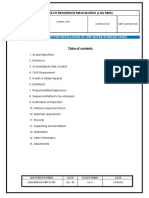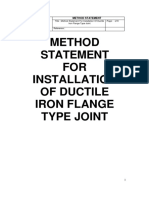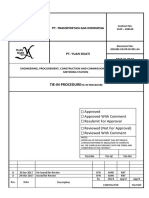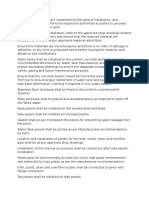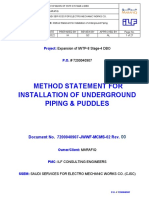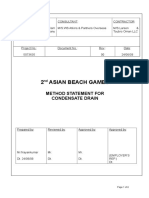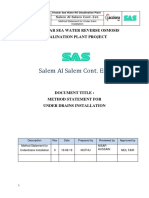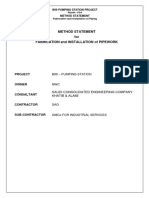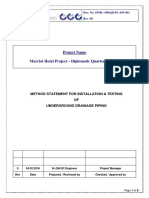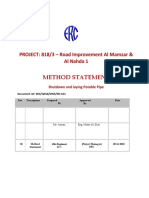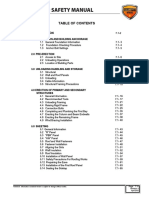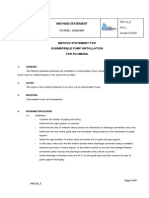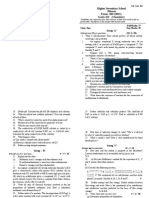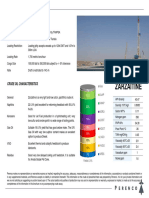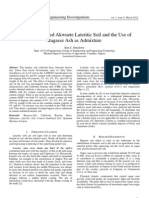METHOD STATEMENT FOR PVC - Upvc-Cpvc
METHOD STATEMENT FOR PVC - Upvc-Cpvc
Uploaded by
Ahmed ImranCopyright:
Available Formats
METHOD STATEMENT FOR PVC - Upvc-Cpvc
METHOD STATEMENT FOR PVC - Upvc-Cpvc
Uploaded by
Ahmed ImranOriginal Title
Copyright
Available Formats
Share this document
Did you find this document useful?
Is this content inappropriate?
Copyright:
Available Formats
METHOD STATEMENT FOR PVC - Upvc-Cpvc
METHOD STATEMENT FOR PVC - Upvc-Cpvc
Uploaded by
Ahmed ImranCopyright:
Available Formats
PROJECT: EXPANSION OF IWTP-8 STAGE-4 DBO
OWNER: MARAFIQ
SSEM: SAUDI SERVICES FOR ELECTRO MECHANIC WORKS CO.
TITLE: METHOD STATEMENT FOR
SPECIAL PROCESS FOR INSTALLATION AND JOINING OF CPVC
& PVC/uPVC PIPES
Revision Revision Date Prepared By Reviewed By Approved By Page No.
00 AUG 3, 2022 IA AL AI 1 of 16
Project: Expansion of IWTP-8 Stage-4 DBO
P.O. # 7200040907
METHOD STATEMENT FOR
SPECIAL PROCESS FOR INSTALLATION
AND JOINING OF CPVC & PVC/uPVC PIPES
Document No. 7200040907-JWWF-MCMS-06 Rev. 00
OWNER / CLIENT: MARAFIQ
PMC: ILF CONSULTING ENGINEERS
SSEM: SAUDI SERVICES FOR ELECTRO MECHANIC WORKS CO. (CJSC)
Doc No. 7200040907-JWWF-GC-060 Rev 00 P.O. # 7200040907
PROJECT: EXPANSION OF IWTP-8 STAGE-4 DBO
OWNER: MARAFIQ
SSEM: SAUDI SERVICES FOR ELECTRO MECHANIC WORKS CO.
TITLE: METHOD STATEMENT FOR
SPECIAL PROCESS FOR INSTALLATION AND JOINING OF CPVC
& PVC/uPVC PIPES
Revision Revision Date Prepared By Reviewed By Approved By Page No.
00 AUG 3, 2022 IA AL AI 2 of 16
TABLE OF CONTENTS
SECTION DESCRIPTION PAGE
1.0 PROJECT DESCRIPTION 3
1.1 PURPOSE AND SCOPE 3
2.0 REFERENCES AND STANDARDS 3
3.0 ACRONYMS, ABBREVIATIONS & DEFINITIONS 4
4.0 RESOURCES AND MANPOWER 4
5.0 RESPONSIBILITIES OF KEY PERSONNEL 5
6.0 WORK PROCEDURE 7
7.0 HSE REQUIREMENTS 14
8.0 DOCUMENTS AND PLANNING 16
9.0 PLANT & EQUIPMENT 16
10.0 QUALITY CONTROL AND ASSURANCE 16
11.0 TRAINING 16
Doc No. 7200040907-JWWF-GC-060 Rev 00 P.O. # 7200040907
PROJECT: EXPANSION OF IWTP-8 STAGE-4 DBO
OWNER: MARAFIQ
SSEM: SAUDI SERVICES FOR ELECTRO MECHANIC WORKS CO.
TITLE: METHOD STATEMENT FOR
SPECIAL PROCESS FOR INSTALLATION AND JOINING OF CPVC
& PVC/uPVC PIPES
Revision Revision Date Prepared By Reviewed By Approved By Page No.
00 AUG 3, 2022 IA AL AI 3 of 16
1.0 PROJECT DESCRIPTION
MARAFIQ is a Power & Water Utility Company for Jubail and Yanbu, desires to expand IWTP-8 which will be called
Stage-4 with treatment capacity of 125,000m3/day. The plant will be designed to have layout for future Re-use treatment
plant that will further treat 80,000 m3/day of IWTP-8 Stage-4 effluent to meet Demineralization Feed water quality.
The Expansion project contract is based on a Design, Build and Operate (DBO) concept broken down into an
Engineering, Procurement and Construction (EPC) part and an Operation and Maintenance (O&M) part. The EPC project
duration will be for 36 months from Commencement Date, while the O&M period of the contract will be for 5 years from
Initial Acceptance of the Works from MARAFIQ.
For further details, refer Document No. MSCF-1-PC-057 Attachment D EPC Scope of Work of Contract
The SSEM will provide design and construction drawings, supervision of work, labor, construction plant and equipment,
materials, tools, Quality control and coordination to execute the works in accordance with the relevant design drawings,
Standards and specifications.
1.1 PURPOSE AND SCOPE
The main purpose of this documents is to elaborate the common practice for the installation and joining of CPVC &
PVC/uPVC PIPES underground and above ground piping. This method of statement is applicable to all CPVC and
PVC/uPVC pipe diameters. The purpose of this method statement is to describe the procedure and methodology to be
adopted as a part of UPVC Underground and above ground drainage pipes & fittings installation for the Construction of
Expansion of IWTP-8 Stage-4 DBO. This document should be read in conjunction with the Project Quality Plan and
Contract Specifications
2.0 REFERENCES AND STANDARDS
All work done in the scope of contractor will be executed in accordance, but not limited, with the following documents.
Where specifications are not clear or covered by these documents the client will be informed and applicable documents will
be provided by the client in order to have clarity on requirements that should be achieved.
Following references & standards are applicable to this MOS:
ASME B31.3 CHEMICAL PLANT & PETROLEUM REFINERY PIPING
AWWA C901-08 POLYETHYLENE (PE) PRESSURE PIPING AND TUBING Y, IN. (13 mm)
AWWA C906-15 Polyethylene (PE) Pressure Pipe and Fittings, 4 In. Through 65 In.
(100 mm Through 1,650 mm), for Waterworks
ASTM 02321 Underground Installation of Flexible Thermoplastic Sewer Pipe
ASTM 02564 Solvent Cement for PVC Plastic Pipe and Fittings
ASTM 02855 Solvent Cemented Joints with PVC Pipe and Fittings
ASTM F493 Solvent Cements for CPVC Plastic Pipe and Fittings
ASTM F585 Insertion of Flexible Polyethylene Pipe into Existing Sewers
Doc No. 7200040907-JWWF-GC-060 Rev 00 P.O. # 7200040907
PROJECT: EXPANSION OF IWTP-8 STAGE-4 DBO
OWNER: MARAFIQ
SSEM: SAUDI SERVICES FOR ELECTRO MECHANIC WORKS CO.
TITLE: METHOD STATEMENT FOR
SPECIAL PROCESS FOR INSTALLATION AND JOINING OF CPVC
& PVC/uPVC PIPES
Revision Revision Date Prepared By Reviewed By Approved By Page No.
00 AUG 3, 2022 IA AL AI 4 of 16
3.0 ACRONYMS, ABBREVIATIONS AND DEFINITIONS
3.1 ACRONYMS, ABBREVIATIONS
SSEM Saudi Services for Electro Mechanic Works Co. (Closed Joint Stock Company)
PMC Project Management Consultant
ISO International Organization for Standardization
OEM Original Equipment Manufacturer
EPC Engineering, Procurement and Construction
O&M Operation & Maintenance
IFC Issue for Construction
PM Project Manager
CM Construction Manager
QMS Quality Management System
QA Quality Assurance
QC Quality Control
Contractor The main Contractor of Project
Sub-contractor Construction Sub-Contractor
ITP Inspection & Test Plan
RFI Request for Inspection
NCR Non-Conformance Report
HSE Health Safety and Environment
MSDS Material Safety Data Sheets
PPE Personal Protective Equipment
PTW Permit to Work
DN / PN Design Pressure / Nominal Pressure
MEP MECHANICAL, ELECTRICAL & PLUMBING
4.0 RESOURCES AND MANPOWER
The team members in all key positions, which require approval from the client, has been submitted
to the client for pre-approval or in approval stage. Positions not requiring approval from the client
will have the required qualified and experienced needed for their position in order to complete
their responsibilities successfully.
Should there is need to accelerate the progress and catch-up the project schedule SSEM sub-
contractors may be employed any time but would function as part of SSEM’s team. List of SSEM
sub contractors will be made available once their qualification is approved by the client and
mobilized to site.
Doc No. 7200040907-JWWF-GC-060 Rev 00 P.O. # 7200040907
PROJECT: EXPANSION OF IWTP-8 STAGE-4 DBO
OWNER: MARAFIQ
SSEM: SAUDI SERVICES FOR ELECTRO MECHANIC WORKS CO.
TITLE: METHOD STATEMENT FOR
SPECIAL PROCESS FOR INSTALLATION AND JOINING OF CPVC
& PVC/uPVC PIPES
Revision Revision Date Prepared By Reviewed By Approved By Page No.
00 AUG 3, 2022 IA AL AI 5 of 16
Organization Chart
SSEM PM – Wael
Fathy
CONSTRUCTION MANAGER
AHMED IBRAHEEM
QA/QC MANAGER
MOHAMMED ISMAIL ELDEEB SAFETY MANAGER
NADJME
CIVIL LEAD ENGINEER /
QA / QC
MECHANICAL/ PIPING LEAD SITE ENGINEERS
SUPERVISOR / MUSAAB KHALID / HUSSAM,
ELECTRICAL/ INSTRUMENTATION
INSPECTOR ENGINEER / BENJAMIN, MAGDY, YAZAN, LEAD ENGINEER /
WALEED / AZHAR SITE ENGINEERS MUKHTAR SITE ENGINEERS
CAEMAR / ZAMAN TBA / ARIF MOHAMMAD TBA
MECHANICAL SUPERVISORS CIVIL SUPERVISORS ELECTRICAL SUPERVISORS
PTW COORDINATOR
TBA
SITE EXECUTION LEADMEN / SITE EXECUTION WORKERS
TBD
Doc No. 7200040907-JWWF-GC-060 Rev 00 P.O. # 7200040907
PROJECT: EXPANSION OF IWTP-8 STAGE-4 DBO
OWNER: MARAFIQ
SSEM: SAUDI SERVICES FOR ELECTRO MECHANIC WORKS CO.
TITLE: METHOD STATEMENT FOR
SPECIAL PROCESS FOR INSTALLATION AND JOINING OF CPVC
& PVC/uPVC PIPES
Revision Revision Date Prepared By Reviewed By Approved By Page No.
00 AUG 3, 2022 IA AL AI 6 of 16
5.0 RESPONSIBILITIES OF KEY PERSONNEL
All actionable responsibilities mentioned in this section for each position will be responsible for
the tasks briefly state against each position.
5.1 CONSTRUCTION MANAGER
Shall be responsible for the site implementation of these procedures and to provide all the
resources from competent and trained manpower, tools, equipment and approved
materials. He shall coordinate with the Quality Control Inspector for inspections and
issuance of Request for Inspections (RFI). He shall be responsible for the safety of all
personnel working on these activities.
5.2 Site Mechanical Engineer
Shall be responsible for overall execution of works, and also responsible for
following all HSE and quality procedure.
5.3 QA/QC MANAGER
Managing the development and implementation of the QMS for planning, fabrication,
inspection, documentation, and operations activities including: Planning duties within the
QA/QC staff and related work schedules.
5.4 QA/QC Engineer
The QA/QC engineer will be responsible for the quality aspects of the works. He will ensure
that project QA and QC plan as per ITPs and other QA/QC documents are in accordance
with vendor procedures and other quality documents. The required (RFIs) will be submitted
to the MARAFIQ/ILF. He will proactively coordinate with the material engineer and issue
appropriate internal (Site Instructions) when he sees that performance of works deviate
from the approved method of statement or project and vendor specifications.
5.5 SAFETY MANAGER MANAGER
Shall be responsible for the implementation of all safety requirements and to ensure that
the works are undertaken in a safe and proper manner, all in accordance with
the approved Construction Phase HSE Plan, the approved method statement and the
approved Job Safety Analysis.
Ensure that the procedures and risk assessment are understood, complied and applied in
the worksite. Ensure that all workers are provided with enough/complete information
regarding workplace hazards and planned control measures.
Doc No. 7200040907-JWWF-GC-060 Rev 00 P.O. # 7200040907
PROJECT: EXPANSION OF IWTP-8 STAGE-4 DBO
OWNER: MARAFIQ
SSEM: SAUDI SERVICES FOR ELECTRO MECHANIC WORKS CO.
TITLE: METHOD STATEMENT FOR
SPECIAL PROCESS FOR INSTALLATION AND JOINING OF CPVC
& PVC/uPVC PIPES
Revision Revision Date Prepared By Reviewed By Approved By Page No.
00 AUG 3, 2022 IA AL AI 7 of 16
5.6 COORDINATOR
Responsible for taking all necessary steps to prepare, authorize, and issue the Permit to
Work after assessing the work and work site and/or area hazards and the controls to
address these hazards.
6.0 WORK PROCEDURE
6.1 Delivery, Storage, Handling & Preservation
• On site pipe storage shall meet all manufacturers' requirements.
• Solvent cement and primer for thermoplastic piping shall be stored in an airconditioned building with a
maximum temperature of 26.rC.
• Pipe and fittings shall be properly protected from impact, especially on their ends. They shall not be thrown,
dropped, bumped, hit, or dragged and pushed over abrasive surfaces.
• Adhesive and solvent cement containers shall be tightly closed when not in use, and shall be returned to
the storage facilities to minimize exposure to excessive temperatures.
• Transport individual pipe lengths to the job site on padded bunks with nylon tie-down straps or padded bonding to
protect the pipe.
• Protect the pipe from sharp objects.
• Anchor pipe securely to prevent slippage.
Store individual pipe lengths on earth berms or timber cradles in the numerical order of installation.
• Stack the heaviest series of pipe at the bottom. Do not stack pipe in excess of 20-rows high.
• Protect the pipe from stones and sharp objects.
• Store fittings in their original cartons.
• Lift pipes with handling beams or wide belt slings near the middle of joints as recommended by the pipe
manufacturer.
• Do not use cable slings, chains, or hooks.
• Before installation, check pipe and fittings for cuts, scratches, gouges, buckling, kinking, or splitting.
• Remove any pipe section containing defects by cutting out the damaged section in a complete cylinder.
• All the damaged pipe should be stored in quarantine area with identification mark.
For Preservation below actions shall be taken
• Solvent cement primer and adhesive containers shall be protected from direct sunlight.
• CPVC /PVC/uPVC pipes must be covered with suitable sheet or should be stored under shade in order to avoid
damage the material due to direct sun light.
• Material storage area should be visited and inspected all material on weekly basis.
• For long term storage, pipe racks should provide continues support, but if this is not possible, timber of at least
Doc No. 7200040907-JWWF-GC-060 Rev 00 P.O. # 7200040907
PROJECT: EXPANSION OF IWTP-8 STAGE-4 DBO
OWNER: MARAFIQ
SSEM: SAUDI SERVICES FOR ELECTRO MECHANIC WORKS CO.
TITLE: METHOD STATEMENT FOR
SPECIAL PROCESS FOR INSTALLATION AND JOINING OF CPVC
& PVC/uPVC PIPES
Revision Revision Date Prepared By Reviewed By Approved By Page No.
00 AUG 3, 2022 IA AL AI 8 of 16
3in bearing width at spacing not greater than 2ft. centers for pipe sizes 160mm and above should be placed
beneath the pipes and at 1.5m centers at the side, if the stacks are rectangular.
• For temporary storage in the field, where racks are not provided, the ground should be level and free from
loose stones. Pipes should not exceed three layer high and should be stacked to prevent.
• Stack heights should be reduced if pipe are nested, etc. .. pipes stored inside pipes of larger diameter.
Reduction in height should be proportional to the weight of the nested pipe compared to the weight of the
pipes normally contained in such stowage.
• Any primer, solvent cement, or adhesive that is beyond the stamped expiration date shall be discarded.
Solvent cement that has gelled or thickened shall be discarded. Leaking or opened containers shall also be
discarded.
6.2 Qualifications of Installers of Plastic Piping.
Each operator performing fusion joining shall be qualified in the use of the manufacturer's recommended fusion
procedure(s) by the following:
Appropriate training or experience in the use of the fusion procedure.
1. Making a sample joint according to the procedure that passes the following inspections and tests:
a) The joint shall be visually examined during and after joining and found to have the same appearance as a photograph
or sample of an acceptable joint that was joined in accordance with the procedure; and
b) The joint shall be tested or examined by 1 of the following methods:
• Pressure and tensile test
• Cut into at least 3 longitudinal straps, each of which is :
• Visually examined and found to be free of voids or unbonded areas on the cut surface of the joint, and
• Deformed bending, torque, or impact and if failure occurs, it must not initiate in the joint area.
2. Each operator shall be re-qualified under the procedure if during any 12month period:
a) Operator has not made any joints under the procedure; or
b) Operator has 3 points or 3% of the joints made, whichever is greater, that are found unacceptable by testing
according to same procedure.
6.3 JOINING METHOD/ ASSEMBLING PROCEDURE OF PVC I uPVC PIPES
6.3.1 TYPES OF JOINTS
There are two major types of joints, namely;
A. SOLVENT WELD JOINTS
B. RUBBER RING SEAL JOINTS
Installation of Thermoplastic Pipes i.e All PVC/uPVC/ CPVC pipe shall be assembled, and installed in accordance with
ASTM code, manufacturer's recommendations, and this procedure. Joints shall be made in accordance with ASTM 02855
for PVC and ASTM F493 for CPVC. Solvent cement shall conform to the following ASTM Designations:
Doc No. 7200040907-JWWF-GC-060 Rev 00 P.O. # 7200040907
PROJECT: EXPANSION OF IWTP-8 STAGE-4 DBO
OWNER: MARAFIQ
SSEM: SAUDI SERVICES FOR ELECTRO MECHANIC WORKS CO.
TITLE: METHOD STATEMENT FOR
SPECIAL PROCESS FOR INSTALLATION AND JOINING OF CPVC
& PVC/uPVC PIPES
Revision Revision Date Prepared By Reviewed By Approved By Page No.
00 AUG 3, 2022 IA AL AI 9 of 16
ASTM 02564 for joining PVC to PVC, and ASTM F493 for joining CPVC to CPVC or PVC. Primer and solvent cement shall
be handled in accordance with the safety precautions in ASTM F402 for restrained type joints.
Solvent cement shall not be used past the manufacturer's expiry date on the label or one year past the date of
manufacture if there is no expiry date specified.
A. Solvent Weld Joints.
- Cutting and Chamfering: Pipes should be cut square with proper marking around the pipe.
- Pipes end should be chamfered at an angle of approximately 15°C to about1/3 of the wall thickness with a coarse file,
chamfering tools.
- Pipes up to 75mm may be jointed easily with solvent adhesive and larger pipes required more special torniquets.
- Mark depth of entry of the size of the pipe into the socket and alignment mark. Roughen the outside of the pipe and
inside of the socket using sandpaper or emery cloth up to entry mark. Clean both surface and remove all dust &
grease using a dry clean cloth and cleaner.
- Apply adhesive without delay after cleaning. using a flat clean and proper brush, where loose fits are found, the pipe
should be given a second coat.
Immediately insert the pipe into the socket up to entry mark. align pipe and socket. Hold in position for a few second.
then wipe off excess cement.
- After the joint has been made. the piping shall not be moved until the drying time listed in Table of this Standard, has
elapsed. To limit movement of a pipe string, the first pipe shall be backfilled with the joint exposed.
Joint Drying Time before Movement Surface Temperature
Hot Weather Above 32 65"C Mild Weather Cold Weather Below 10"C
THROUGH NOMINAL PIPE SIZE
32 12 min 20 min 30 min
63 30 min 45 min 60 min
110 45 min 60 min 90 min
225 60 min 90 min 150 min
Note: These temperatures are pipe surface temperatures and are not air temperature limitations.
B. Rubber Ring Seal Joints
- Ensure that the spigot and socket are free from dust. grit, grease and as dry as possible. In hot climate joining is
recommended in early morning or in the evening to prevent expansion & contraction in excessive amount.
- Insert pipe into the socket without seal ring in place and mark pipe when it is fully inserted.
- Place seal in groove of socket ensuring that seal is correct way round. Rubber seal rings should be fitted with tapered
section facing the outside of the socket
- Apply jointing lubricant to the chamfer and the end of the spigot of the pipe or fitting only. Push the pipe firmly into
the socket up to the insertion mark previously made. If an expansion gap is requiring the pipe is then pulled back by
desired amount according the size.
- Jointing clamps may be used for ease of assembly.
Doc No. 7200040907-JWWF-GC-060 Rev 00 P.O. # 7200040907
PROJECT: EXPANSION OF IWTP-8 STAGE-4 DBO
OWNER: MARAFIQ
SSEM: SAUDI SERVICES FOR ELECTRO MECHANIC WORKS CO.
TITLE: METHOD STATEMENT FOR
SPECIAL PROCESS FOR INSTALLATION AND JOINING OF CPVC
& PVC/uPVC PIPES
Revision Revision Date Prepared By Reviewed By Approved By Page No.
00 AUG 3, 2022 IA AL AI 10 of 16
6.4 INSTALLATION & ASSEMBLING OF PVC/ uPVC / CPVC PIPES
• Field-fabricated, mitered fittings shall not be used.
• Thermoplastic flanges when used, shall be of flat face. Mating flanges of different approved material shall also
be of flat face. They shall be assembled with full-face elastomeric gaskets, 3 mm thick, and 50 to 60 Shore A
Durometer hardness.
• Flat washers shall be used under nuts and bolt heads on nonmetallic flanges.
• Plastic pipes such as PVC, UPVC, CPVC, PP. etc. shall be protected from contact with concrete by tape or
neoprene wrapping.
• At the edges where a thermoplastic pipe or fitting enters or leaves a thrust block, it shall be wrapped with
neoprene wrapping that will protrude slightly from the block.
• All changes of direction must be anchored. Concrete thrust blocks are suitable if require from design, but the
unit should only be hunched and a flexible membrane interposed between the concrete and the unit, to protect it
against damage by abrasion.
• The pipeline should be tested initially after a few joints to ensure that they have been made correctly, and
subsequently at convenient intervals, preferably not exceeding 1000 meters.
• Before testing, the line must be backfilled leaving the joints exposed. If the joints must be covered, it is useful to
mark their position.
• It is very important when laying uPVC pipes for gravity drainage to ensure that the pipe is laid in accordance
with the recommendations of the manufacturer.
6.5 Trench Preparation for underground piping
Following points should be considered during trench excavation
Take necessary safety precautions to ensure a safe working environment.
Prevent water penetration into the trench.
During excavation, make sure that trench walls keep vertical position.
for a flat bedding, remove all obstacles and sharp edges such as rocks, gravels, concrete, etc. from the
trench
Remove all organic items such as plants, tree roots, etc. from trench ground.
Ensure that trench ground is strong and stable.
If the trench ground is not stable enough. increase trench depth for stabilization works.
Discharge water (if there is any) from the trench before bedding preparation.
When the underground water level is high, it might cause pipes to float. To prevent floatation, increase the
trench depth to increase the height of backfilling.
Ensure that trench width is sufficient enough for bedding and backfilling com paction works.
Ensure that excavated materials are piled at a distance from the trench to avoid the possibility of rolling back
into the trench
Doc No. 7200040907-JWWF-GC-060 Rev 00 P.O. # 7200040907
PROJECT: EXPANSION OF IWTP-8 STAGE-4 DBO
OWNER: MARAFIQ
SSEM: SAUDI SERVICES FOR ELECTRO MECHANIC WORKS CO.
TITLE: METHOD STATEMENT FOR
SPECIAL PROCESS FOR INSTALLATION AND JOINING OF CPVC
& PVC/uPVC PIPES
Revision Revision Date Prepared By Reviewed By Approved By Page No.
00 AUG 3, 2022 IA AL AI 11 of 16
Trench walls should be supported with sheet piles if the natural ground soil is unstable.
the minimum trench width from the bottom to 300 mm above the top of the pipe shall be as shown in below
Table.
TYPE OF PIPES NOMINAL PIPE SIZE (mm) MIN WIDTH OF TRENCH (mm)
THERMOPLASTIC 90 and under 300 mm
THERMOPLASTIC 110 and over OD +300
6.5.1 Preparation of Bedding
Trench bedding should be fattened, levelled and compacted all along the trench. Under unstable soil conditions, trench
depth and bedding thickness can be increased. After trench excavation, bedding should be prepared to provide durable
and stable support for pipe. Pipe bedding should not be less than 15cm in height and should be prepared with
compacted granular material at minimum 90% Standard Proctor Density or any other suitable bedding material at
minimum %95 Standard Proctor Density. Bedding depth should be increased if there are unstable, lose or soft soil
conditions. If bedding material is sandy, bedding material should be moisturized and should be compacted with
vibrating compactors. Bedding should always be flat and levelled with the trench bottom. A non-woven geotextile with a
unit weight of at least 100 g/m2 must be placed between the crushed stone and the sand bedding layer to prevent
filtration of the sand bedding into the crushed stone matrix. The trench bottom shall be continuous, smooth, free of
rocks, and to the line and grade shown on the installation drawings. Bedding material characteristics are very important
for a proper support for the pipes. Generally bedding and backfilling materials are preferred to have the same
characteristics. if the excavated material is preferred to be used as backfilling material, characteristics of the excavated
soil should be analyzed for suitability. Another critical point to be taken into consideration is the possibility of
experiencing different soil characteristics along the pipeline.
6.5.2 Installation of Pipe in the Trench and Lifting
After completion of trench excavation and bedding, installation can start in line with the project. Pipes and fittings
should be stored along the pipeline next to the trench according to the daily installation program for a faster and easier
installation. Stored goods should not block the working path of the construction machines such as crane, excavator,
bulldozer, etc lifting straps should be tied around the pipe from the appropriate lifting points. While lifting fittings,
special lifting and alignment requirements should be taken into consideration. (For instance, the arm angle of the Tee
part). lifting can be performed with a crane or with the excavator arm and pipe should be lowered onto the bedding
slowly. During lifting and lowering inside the trench, field teams instruct directions to the excavator operator to make
sure that pipe will be placed at the right location. Pipe should be lowered closer to the previously installed pipe and
should be carefully aligned.
6.5.3 Multiple Pipe in one Trench
During installation of multiple pipes in a single trench, distance between any of the 2 pipes is determined with the
formula (r1+ r2) /2 whereas r1: radius of the first pipe and r2: radius of the second pipe. Complying with the formula or
Manufacturer recommendation for the distance of pipes in the same trench.
6.6 INSPECTION & TEST PLAN.
Doc No. 7200040907-JWWF-GC-060 Rev 00 P.O. # 7200040907
PROJECT: EXPANSION OF IWTP-8 STAGE-4 DBO
OWNER: MARAFIQ
SSEM: SAUDI SERVICES FOR ELECTRO MECHANIC WORKS CO.
TITLE: METHOD STATEMENT FOR
SPECIAL PROCESS FOR INSTALLATION AND JOINING OF CPVC
& PVC/uPVC PIPES
Revision Revision Date Prepared By Reviewed By Approved By Page No.
00 AUG 3, 2022 IA AL AI 12 of 16
- Work execution inspection and test shall be monitored and witnessed as per SSEM ITP and recorded in the
SSEM Inspection checklist and QC forms available in the ITP as applicable.
- Request for Inspection (RFI)QC inspector shall issue a RFI 24 hour and 48 hours for weekend inspection and
remote area location as per Schedule Q in advance of test I inspection to CLIENT PMT to verify the readiness of
the test I Inspection and to inform MARAFIQ/ILF QC inspection in advance.
6.6.1 TESTING REQUIREMENTS
. Visual inspection.
All installed PVC/uPVC pipe and fittings shall be visually inspected for scratches, damaged ends, cracks,
delamination, crushing, weathering. Each piece of PVC/CPVC/uPVC pipe and fitting shall be examined for cuts,
scratches. gouges, kinks, buckles, and ultra-violet (sun) damage. Damaged lengths of pipe shall be cut out and
discarded. Damaged fittings shall be discarded as well.
GRAVITY TEST FOR DRAINAGE PIPE
• The segment or portion of pipe work to be tested shall be slowly filled from the possible lowest point with clean
domestic water and air is released at all high points in the system until the system is completely full.
• During each phase of installation, carry our interim leakage tests using water head, to ensure and prove the
firmness and leak free of joints.
• All openings of pipes should be closed with suitable plug.
• High level end of the pipe is connected to a 90-degree elbow and is connected to a piece of pipe, in order to get
a minimum head of 3 mtr. of water from the low-level point. The vertical pipe should be supported then start
filling the water into the pipe through water hose.
• Fill water carefully to minimize the air bubbles trapped in the line Then open, small opening in the expansion
test plugs such that all air trapped in the line should washed out. Again, fill water up to the required level of 3
mtr. head and keep this pressure head for 2 hours
• After 2 hours, if there is no decrease in level is observed, then the system will be considered tested
successfully. In case of any decrease in level, find out the leak in joints and re-do the test.
6.7 BACKFILLING
When the pipe installation and leak testing is completed and successful, backfilling of the pipe will follow.
However, partial backfilling prior to hydro -testing is permitted provided that the coupling joints or lamination
joints are exposed. During backfilling the following are to be followed:
o Proper selection, placement and compaction of the pipe zone backfill are important for controlling
the vertical deflection and are critical to the pipe performance.
o Attention must be paid so that the backfilling material is not contaminated with debris or other
foreign materials that could damage the pipe or cause loss of side support.
o During backfilling, the granular material should flow completely under the pipe to provide full
support.
o A blunt tool maybe used to push and compact the backfill under the pipe.
o Provide warning tape 300 mm above the top of pipe in burried services. ( Refer RC Section 02085 )
o Proper backfilling should be done in 150 mm to 300mm lifts depending on the backfill material and
compaction material. 300 mm lifts will be adequate for gravel because it is easy to compact.
Doc No. 7200040907-JWWF-GC-060 Rev 00 P.O. # 7200040907
PROJECT: EXPANSION OF IWTP-8 STAGE-4 DBO
OWNER: MARAFIQ
SSEM: SAUDI SERVICES FOR ELECTRO MECHANIC WORKS CO.
TITLE: METHOD STATEMENT FOR
SPECIAL PROCESS FOR INSTALLATION AND JOINING OF CPVC
& PVC/uPVC PIPES
Revision Revision Date Prepared By Reviewed By Approved By Page No.
00 AUG 3, 2022 IA AL AI 13 of 16
o Compaction of sandy backfill is most easily accomplished when the material is near to its optimum
moisture content. When backfilling reaches pipe spring line, all compaction shall be done first near the
trench sides and proceeds towards the pipe.
o It is recommended that placing and compacting of the pipe zone backfill is done in such a way as to
cause the pipe to ovalize slightly in the vertical direction.
The clean sand bedding shall be compacted to 70% Relative Density (ASTM D4253/ASTM D4254). The clean sand
from the bottom of the pipe to 300 mm above the top of the pipe (sand cover) shall be compacted by water
flooding and hand tamping only. No compaction testing is required in this section of the trench. Within 300 mm
of the top of the pipe, backfill shall be hand tamped, or a board shall be used to protect the pipe from damage
from vibratory plate compactors
Backfill above 300 mm sand cover in non-Traffic area shall be on site excavation or borrowed materials that meet
the following conditions:
Type of Pipe Nominal Pipe Size and Minimum
Cover (mm)
Service
Thermoplastic Sewers. gravity flow 900
Thermoplastic Pressure pipe under 100 mm size 600
Thermoplastic Pressure pipe 100 mm and larger 900
sizes
Thermoplastic Irrigation. under 90 mm size 300
Thermoplastic Irrigation. 90 mm and large 600
6.8 TOOLS and MATERIALS
• Hand Saw
• Measuring Tape
• Chalk line & Powder
• Wire Cutter
• Solvent Cement
• Lubricant
• Drilling Machine
• Grinding Machine
• Right Angle
• Ladder or Scaffolding with Platform
• Extension wire for Electrical Power etc.
• PVC/CPVC/uPVC pipe and Fittings
Doc No. 7200040907-JWWF-GC-060 Rev 00 P.O. # 7200040907
PROJECT: EXPANSION OF IWTP-8 STAGE-4 DBO
OWNER: MARAFIQ
SSEM: SAUDI SERVICES FOR ELECTRO MECHANIC WORKS CO.
TITLE: METHOD STATEMENT FOR
SPECIAL PROCESS FOR INSTALLATION AND JOINING OF CPVC
& PVC/uPVC PIPES
Revision Revision Date Prepared By Reviewed By Approved By Page No.
00 AUG 3, 2022 IA AL AI 14 of 16
7.0 HSE REQUIREMENTS
The Health Safety and Environment Project Management Plan institutes the overall mechanism for the
risk management processes with regard to the Project. Processes are implemented at the earliest
stages within the project cycle, identifying risk and facilitating opportunity for the application of
appropriate mitigation strategies. As an integral part of the planning process, prior to the commencement
of any operational activity a suitable and sufficient specific assessment (RA) of the risks associated with
the works should be undertaken. Below are minimum HSE requirements.
All works shall be done in accordance with the MARAFIQ Project HSE Manual and all individual activities shall
be set up in an orderly manner to ensure compliance with the requirements.
Work permit shall be secured by the Site Engineer prior to carrying out any work and work shall proceed in
accordance with the specific measures itemized in the permit
Relevant information on the permit shall be made available to all operative
-performing the work by providing a copy to the Bulletin Board nearest or adjacent to the work area.
The Safety Supervisor I Safety Officer is responsible along with the Site Engineer for ensuring that all
operations are being done with due regard for the safety of personnel property as well as the general public.
All PPEs shall be worn by personnel performing the work at all times in full compliance to safety rules on PPE
Additional PPEs like respirator. rubber hand gloves and disposable coveralls shall be provided during
lamination and grinding works.
Barricades shall be provided to isolate the work area but proper access shall be provided to all operatives.
The work site shall be maintained in a clean and tidy condition
7.1 SAFETY INSTRUCTIONS
. Starting instructions will be given by the supervisors at the start of each activity to explain
the methodology of works and to communicate safe working procedures to the operatives.
These talks are structured in a way to highlight to major risks involved in the activity and
the various control measures required in order to minimize the risk. It is delivered in a
manner such as the key points will be remembered by the operatives receiving it.
. Toolbox talk meetings will be held for each crew, on group or employees, regarding more
general topics of the Project HSE Policy; in example lesson learned, near miss reports,
implementation of the requirements and message from the LBS management or
Employers HSE personnel.
7.2 Personal Protective Equipment’s
Doc No. 7200040907-JWWF-GC-060 Rev 00 P.O. # 7200040907
PROJECT: EXPANSION OF IWTP-8 STAGE-4 DBO
OWNER: MARAFIQ
SSEM: SAUDI SERVICES FOR ELECTRO MECHANIC WORKS CO.
TITLE: METHOD STATEMENT FOR
SPECIAL PROCESS FOR INSTALLATION AND JOINING OF CPVC
& PVC/uPVC PIPES
Revision Revision Date Prepared By Reviewed By Approved By Page No.
00 AUG 3, 2022 IA AL AI 15 of 16
All workers will be issued and trained in use of the required PPE equipment to comply with contract procedures and
local regulations and will be supplemented with PPE as required by MSDS & Risk Assessments. This will include but will
not be limited to;
Hard Hats
Safety Boots with ankle support and steel toe caps
Safety Goggles
High Visibility Vests / Overalls with integrated reflective strips
Hand gloves
Face Masks
A variety of mechanisms, such as method statement briefings and toolbox talks will be
implemented to ensure all relevant personnel are appropriately informed.
In addition to their safety induction received at their arrival on site, all the workers will have a
toolbox meeting in order to be briefed about the risks of their specific work task, prior to start of works.
7. 3 ENVIRONMENTAL ISSUES
As part of the development of the Organization’s Environmental Management System(s) the
significant issues that are faced both on site and within offices or other facilities should be
addressed. This approach subsequently allows for a systematic focus upon the important
environmental aspects to be adopted which in turn facilitates prioritization of limited
resources.
7.3.1 MITIGATION MEASURES
Toolbox talks and care shall be taken to use plenty of water during high humidity weather.
General housekeeping rules for all operatives shall be observed.
Stationary equipment e.g. lighting towers, gensets etc. will have containment trays beneath.
Maintaining good housekeeping minimizes hazardous waste production by increasing the
likelihood that chemicals will be used before they expire and reducing the need to clean up
chemical spills.
Hazardous substances shall be stored as per manufacturer’s recommendation or as
mentioned in safety data sheet.
Hazardous waste shall be collected and disposed in hazardous waste skip.
Spill kits shall be made available on site.
Dip tray with a capacity of 110% shall be provided to control the chemical spill.
Doc No. 7200040907-JWWF-GC-060 Rev 00 P.O. # 7200040907
PROJECT: EXPANSION OF IWTP-8 STAGE-4 DBO
OWNER: MARAFIQ
SSEM: SAUDI SERVICES FOR ELECTRO MECHANIC WORKS CO.
TITLE: METHOD STATEMENT FOR
SPECIAL PROCESS FOR INSTALLATION AND JOINING OF CPVC
& PVC/uPVC PIPES
Revision Revision Date Prepared By Reviewed By Approved By Page No.
00 AUG 3, 2022 IA AL AI 16 of 16
Unauthorized personnel entry shall be restricted.
Organize the work and setup tools and equipment correctly.
Check all equipment’s are in good working condition.
8.0 DOCUMENTS AND PLANNING
Work will be performed in accordance with the APPROVED documents; IFC Drawing for Building, Tanks,
Foundation and other structural elements, planning schedule will be updated for delivery and shifting of
material. All lead mechanical engineer site mechanical engineer and material engineer shall have a 3-
weeks look ahead schedule of GRP stock inventory.
9.0 PLANT & EQUIPMENTS
SSEM will provide necessary tools and machinery, manual and torquing tool throughout the project which is depending
upon its requirements. Quantities will be determined by actual site/Store demand. Equipment will be inspected prior
utilizing.
10.0 QUALITY CONTROL AND ASSURANCE RECORDS
All records relevant to the above procedure will be retained by the Quality Control department in the site office, for the
duration of the project, before being handed over to the Contractor in accordance with the requirements of the contract
documents. Copies of all records will be made and transferred to the Contractor Office where they will be retained for
the guarantee period of the contract.
Approved MRIs / RFIs
IFC
Approved Material Receiving RFI
11.0 TRAINING
Training will be providing as per training and project schedule.
HSE Induction and General Safety Awareness Training
Heat Stress Awareness Training
PTW (Permit to Work) Procedure Training
Lifting and rigging activities at Store / Site.
Quality Induction Training
First Aid Training
Doc No. 7200040907-JWWF-GC-060 Rev 00 P.O. # 7200040907
PROJECT: EXPANSION OF IWTP-8 STAGE-4 DBO
OWNER: MARAFIQ
SSEM: SAUDI SERVICES FOR ELECTRO MECHANIC WORKS CO.
TITLE: METHOD STATEMENT FOR
SPECIAL PROCESS FOR INSTALLATION AND JOINING OF CPVC
& PVC/uPVC PIPES
Revision Revision Date Prepared By Reviewed By Approved By Page No.
00 AUG 3, 2022 IA AL AI 17 of 16
Doc No. 7200040907-JWWF-GC-060 Rev 00 P.O. # 7200040907
You might also like
- Method Statement For Underground Piping FCDocument17 pagesMethod Statement For Underground Piping FCmister pogi94% (17)
- 1.method Statement - INSTALLATION OF GRP WATER TANKSDocument11 pages1.method Statement - INSTALLATION OF GRP WATER TANKSsarmad spectrum0% (1)
- Directed Energy Deposition of Metals: Standard Guide ForDocument22 pagesDirected Energy Deposition of Metals: Standard Guide ForPatrícia BNo ratings yet
- 030-Itp For Ug GRP Piping PDFDocument22 pages030-Itp For Ug GRP Piping PDFKöksal Patan90% (10)
- METHOD STATEMENT FOR PVC - Upvc-CpvcDocument17 pagesMETHOD STATEMENT FOR PVC - Upvc-CpvcAhmed Imran100% (4)
- Steel Structure ErectionDocument33 pagesSteel Structure ErectionAhmed Imran100% (2)
- Method Statement For Underground Piping & Puddles InstallationDocument27 pagesMethod Statement For Underground Piping & Puddles InstallationAhmed Imran100% (1)
- Method Statement Ductile Iron Flange Type Joint Pipe LTESTDocument8 pagesMethod Statement Ductile Iron Flange Type Joint Pipe LTESTmuhammad syauqi shaidanNo ratings yet
- Installation Procedure For Catch BasinDocument2 pagesInstallation Procedure For Catch BasinFlorante NoblezaNo ratings yet
- Installation Method Statement of HDPE Piping PDFDocument5 pagesInstallation Method Statement of HDPE Piping PDFvignesh75% (4)
- MES For GRP Pipes InstallationDocument23 pagesMES For GRP Pipes InstallationTaiwo Oshin100% (2)
- Method Statement For Pump InstallationsDocument4 pagesMethod Statement For Pump InstallationsAnonymous xyZH2OaUV100% (4)
- Method Statement Installation of UPVC Drainage FINALDocument4 pagesMethod Statement Installation of UPVC Drainage FINALanon_31671419463% (8)
- MS For Installation of Pipe Sleeves For Fire Protection Works (Final Submission)Document7 pagesMS For Installation of Pipe Sleeves For Fire Protection Works (Final Submission)Imho TepNo ratings yet
- Iron Mongeries-Method StatementDocument4 pagesIron Mongeries-Method StatementFouad Fawaz100% (1)
- Tie in Procedure Rev. BDocument8 pagesTie in Procedure Rev. BgenjiNo ratings yet
- GRP TANK Installation Method StatementDocument2 pagesGRP TANK Installation Method StatementQasim Khan82% (11)
- Engine Catalogue PDFDocument40 pagesEngine Catalogue PDFPavana Shet100% (2)
- Product Description: Amplitex Art. No. 5040 Flax Balanced Weave (0°/90°) 300 GSMDocument2 pagesProduct Description: Amplitex Art. No. 5040 Flax Balanced Weave (0°/90°) 300 GSMMcFlyNo ratings yet
- Mathod Statement of Duct InsulationDocument14 pagesMathod Statement of Duct InsulationAhmed AlyNo ratings yet
- Method Statement For GRP Flange Assembly WorkDocument17 pagesMethod Statement For GRP Flange Assembly WorkAhmed ImranNo ratings yet
- Method Statement For Underground Piping & Puddles InstallationDocument27 pagesMethod Statement For Underground Piping & Puddles InstallationAhmed Imran100% (1)
- Method of Statement For GRP WorkDocument17 pagesMethod of Statement For GRP WorkAhmed IbrahimNo ratings yet
- Method Statement For Underground PVC Pipe InstallationDocument44 pagesMethod Statement For Underground PVC Pipe InstallationSaad Amer100% (2)
- Method Statement For Installation & Hydrotest of GRP & Upvc PipesDocument19 pagesMethod Statement For Installation & Hydrotest of GRP & Upvc PipesBAVA M.HNo ratings yet
- Method Statement For Installation of PVC PipesDocument23 pagesMethod Statement For Installation of PVC Pipeschathura dharmasena100% (1)
- Method of Statement For HDPE Pipe InstallationDocument2 pagesMethod of Statement For HDPE Pipe InstallationYe Yint100% (3)
- Method Statement-Condensate DrainDocument6 pagesMethod Statement-Condensate DrainFark Off100% (1)
- FF Installation System Method StatementDocument9 pagesFF Installation System Method StatementAchmad Fikri Rabbani100% (1)
- Method Statement For Installation of PVC uPVC Drainage Piping Under Above GroundDocument9 pagesMethod Statement For Installation of PVC uPVC Drainage Piping Under Above Groundanver.yusifNo ratings yet
- Method Statement For Leakage Testing of Gravity Sewer LineDocument3 pagesMethod Statement For Leakage Testing of Gravity Sewer LinePrem Kumar100% (2)
- Method Statement of Potable Water and Firefighting Network ConstructionDocument51 pagesMethod Statement of Potable Water and Firefighting Network Constructionmohdshahul543No ratings yet
- INCO-MS-PIP-0009-SAFE WORK Method Statement For Piping Support FabricationDocument8 pagesINCO-MS-PIP-0009-SAFE WORK Method Statement For Piping Support FabricationHichem BklNo ratings yet
- Method StatementDocument6 pagesMethod Statementanon_208207357No ratings yet
- Method Statement of Installation of UNDER DRAINSDocument8 pagesMethod Statement of Installation of UNDER DRAINSMuthuram NNo ratings yet
- Method Statement For Piping Works - B99 Pump StationDocument14 pagesMethod Statement For Piping Works - B99 Pump StationMohamed100% (1)
- Method Statments For Mechanical WorksDocument34 pagesMethod Statments For Mechanical WorksUmar Farooq100% (1)
- Method Statement For Installation & Testing of Underground Drainage PipingDocument18 pagesMethod Statement For Installation & Testing of Underground Drainage PipingMohammed Mostafa El HaddadNo ratings yet
- YT-PF-Z-16-00202 Rev B Method Statement of GRPDocument47 pagesYT-PF-Z-16-00202 Rev B Method Statement of GRPsethu1091100% (9)
- Method Statement For Installationtesting Commissioning of External Fire HydrantDocument11 pagesMethod Statement For Installationtesting Commissioning of External Fire Hydrantriswan0% (1)
- MOS CPVC Hydrostatic Pressure - LatestDocument9 pagesMOS CPVC Hydrostatic Pressure - Latestharun yucelNo ratings yet
- Method of Statement Shutdown Water LineDocument10 pagesMethod of Statement Shutdown Water LineFrancis Mier SereñoNo ratings yet
- SA04C2-T-MET-AAG-00037 Hydrotest Method StatementDocument25 pagesSA04C2-T-MET-AAG-00037 Hydrotest Method StatementABAID ULLAH100% (2)
- Chilled Water Pipe Insulation Method Statement - Method Statement HQDocument3 pagesChilled Water Pipe Insulation Method Statement - Method Statement HQابوزيد عبد الجوادNo ratings yet
- Method Statement For Leakage Testing of Gravity Sewer LineDocument3 pagesMethod Statement For Leakage Testing of Gravity Sewer LineGerlie DimayugaNo ratings yet
- Amiantit. Field Installation ProcedureDocument37 pagesAmiantit. Field Installation ProcedureABAID ULLAHNo ratings yet
- Method Statement For The Flushing of Firefighting Pipes.R7Document9 pagesMethod Statement For The Flushing of Firefighting Pipes.R7adel rihanaNo ratings yet
- Method Statement Hdpe Welding PDF FreeDocument35 pagesMethod Statement Hdpe Welding PDF FreeGopinath SekarNo ratings yet
- Method Statement of Installation of Ductile Iron FlangeDocument10 pagesMethod Statement of Installation of Ductile Iron Flangemuhammad syauqi shaidan50% (2)
- Ms-008 Piping Works - Rev 01Document8 pagesMs-008 Piping Works - Rev 01Rafael Echano Acedera100% (1)
- 5 Formwork ChecklistDocument81 pages5 Formwork ChecklistAlphaNo ratings yet
- Installation and Leakage Testing Method Statement of Drainage Piping (Ground Zero)Document2 pagesInstallation and Leakage Testing Method Statement of Drainage Piping (Ground Zero)Al Mumeen Construction ServicesNo ratings yet
- ITP - (Pressure Testing Piping) PDFDocument3 pagesITP - (Pressure Testing Piping) PDFSUNNY BOSS100% (1)
- Method Statement Risk Assessment For Pump Installation 2Document4 pagesMethod Statement Risk Assessment For Pump Installation 2fraza40% (5)
- Method Statement For Valve InstallationDocument9 pagesMethod Statement For Valve InstallationAmer AmirulNo ratings yet
- Itp PipingDocument18 pagesItp PipingBayu Reza Fauzi100% (1)
- DX SplitDocument29 pagesDX Splitsiva_nagesh_2No ratings yet
- QES PEVC-ENG237 - Checklist For PSS Fencing DetailsDocument2 pagesQES PEVC-ENG237 - Checklist For PSS Fencing DetailsRupesh Khandekar100% (2)
- Method Statement of Installation of SS Puddle FlangesDocument7 pagesMethod Statement of Installation of SS Puddle Flangessarmad spectrum100% (2)
- MOS For Installation of Drainage Pipes and FittingsDocument14 pagesMOS For Installation of Drainage Pipes and FittingsHubaibNo ratings yet
- Method Statement of Installation of Ductile Iron FlangeDocument10 pagesMethod Statement of Installation of Ductile Iron FlangeshahidNo ratings yet
- Method Statement For or Installation and Leakage Test For HVAC DuctsDocument15 pagesMethod Statement For or Installation and Leakage Test For HVAC Ductsanver.yusifNo ratings yet
- Tip QC PlanDocument14 pagesTip QC PlanTC Nihal AlcansoyNo ratings yet
- Method Statement For Post Anchor BoltsDocument13 pagesMethod Statement For Post Anchor BoltsAhmed Imran100% (1)
- SOHAIL ASLAM-rolling shutter door expertDocument3 pagesSOHAIL ASLAM-rolling shutter door expertAhmed ImranNo ratings yet
- CRANE OPERATOR-sher afzalDocument2 pagesCRANE OPERATOR-sher afzalAhmed ImranNo ratings yet
- ExcavationDocument24 pagesExcavationAhmed ImranNo ratings yet
- Dewatering Plan For Underground PipingDocument7 pagesDewatering Plan For Underground PipingAhmed Imran100% (1)
- Method Statement For Post Anchor BoltsDocument13 pagesMethod Statement For Post Anchor BoltsAhmed Imran100% (1)
- Method Statement For Installation of Tower CraneDocument26 pagesMethod Statement For Installation of Tower CraneAhmed Imran100% (1)
- Maktex Py 100: Product DescriptionDocument1 pageMaktex Py 100: Product DescriptionHatem ElGabryNo ratings yet
- Process Steam System: Definition - What Does Mean?Document10 pagesProcess Steam System: Definition - What Does Mean?James VincentNo ratings yet
- Astm E350-12Document65 pagesAstm E350-12Norman ricardo RojoNo ratings yet
- Aerospace and Defense Sealed Lead Acid BatteryDocument2 pagesAerospace and Defense Sealed Lead Acid BatteryEdwin HarrisNo ratings yet
- FLOWABILITYDocument2 pagesFLOWABILITYRanda TagNo ratings yet
- E WasteDocument47 pagesE WasteGeorge Dlima67% (9)
- Maxtreat 2925 - MSDSDocument3 pagesMaxtreat 2925 - MSDSLu CianusNo ratings yet
- Geochemistry of Canga (Ferricrete) and Evolution of The Weathering Profile Developed On Itabirite and Iron Ore in The Quadrilátero Ferrífero, Minas Gerais, BrazilDocument28 pagesGeochemistry of Canga (Ferricrete) and Evolution of The Weathering Profile Developed On Itabirite and Iron Ore in The Quadrilátero Ferrífero, Minas Gerais, BrazilNatercia Duarte Drumond JuniaNo ratings yet
- Huile Vascomill-CSF35Document1 pageHuile Vascomill-CSF35heraldNo ratings yet
- Chemistry Semester 1 Exam HCDocument3 pagesChemistry Semester 1 Exam HCcatholic HymnsNo ratings yet
- Antiestatic Additives CIBADocument12 pagesAntiestatic Additives CIBAGli OxalNo ratings yet
- Auxiblocker SBDocument1 pageAuxiblocker SBphasithNo ratings yet
- ICSEM2016 BrochureDocument2 pagesICSEM2016 BrochurePavan KishoreNo ratings yet
- Chemistry XII Prefinal 2067 EurekaDocument3 pagesChemistry XII Prefinal 2067 EurekaManoj KhanalNo ratings yet
- Full Download Eco-Friendly Corrosion Inhibitors: Principles, Designing and Applications Lei Guo PDFDocument64 pagesFull Download Eco-Friendly Corrosion Inhibitors: Principles, Designing and Applications Lei Guo PDFgutuzasim100% (5)
- EN-cybrid Sealant TDS 1Document2 pagesEN-cybrid Sealant TDS 1loydtarrosaNo ratings yet
- Perovskite Solar Cell NOTESDocument3 pagesPerovskite Solar Cell NOTESSudhir RanjanNo ratings yet
- ICP & ICP-MS - Inorganic VenturesDocument51 pagesICP & ICP-MS - Inorganic VenturesSussan E PalominoNo ratings yet
- Slabs (LENSCHOW and SOZEN) jl64-27Document8 pagesSlabs (LENSCHOW and SOZEN) jl64-27Pastor PachecoNo ratings yet
- Tunisia ZarzaitineDocument1 pageTunisia ZarzaitineJonas lumbuNo ratings yet
- PTC SensorDocument5 pagesPTC SensorThamil AnbanNo ratings yet
- Loctite SI 5060™: Product DescriptionDocument3 pagesLoctite SI 5060™: Product DescriptionSanthosh Kumar RavichandranNo ratings yet
- Chapter 2 Structure, Properties and Behavior of MatterDocument49 pagesChapter 2 Structure, Properties and Behavior of Matteraxeman1nNo ratings yet
- Cement Stabilized Akwuete Lateritic Soil and The Use of Bagasse Ash As AdmixtureDocument5 pagesCement Stabilized Akwuete Lateritic Soil and The Use of Bagasse Ash As AdmixtureInternational Journal of Science and Engineering Investigations100% (1)
- Politehnica University of Bucharest Faculty of Engineering in Foreign LanguagesDocument5 pagesPolitehnica University of Bucharest Faculty of Engineering in Foreign LanguagesLuizaNo ratings yet
- CamisasDocument32 pagesCamisasRosa ChNo ratings yet
- White-Light-Emitting Diodes For Illumination PDFDocument277 pagesWhite-Light-Emitting Diodes For Illumination PDFRakesh KumarNo ratings yet

